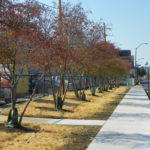Urban Trees and Climate Change… what’s going on and what is expected?
It’s time to really pay closer attention to the impacts of changing climate on our urban forests. Generally speaking, changes will vary across the Midwest and will be challenging to determine exactly what can be done to protect our trees. Also, the once simple task of selecting what will be considered a sustainable tree species in the midst of these extreme changes in weather will be equally challenging. The current urban and suburban environments are tough for growing trees and our changing climate is going to make it even tougher.
- Heat islands can affect communities by increasing summertime air pollution, greenhouse gas emissions, heat-related illness and mortality, and water pollution and tree death.
- Increasing temperatures increase water demands and maintenance inputs.
The greenhouse effect is the warming that results when the atmosphere traps heat radiating from Earth toward space. Scientists attribute global warming and climate change to this greenhouse effect. In addition, human expansion has increased carbon emissions and has become one of the major contributors to our ongoing climate change issues which impacts every tree on the planet. Climate change will continue to bring warmer, and more wet winters and warmer, drier summers; consequently, insect disturbances are expected to increase. Additionally, climate change is further aggravated by existing urban stressors such as air pollution, soil compaction and heat island effects. Since it is unlikely that these issues can be prevented in and around the places we live; it is essential that adaptive strategies be identified and implemented by urban forest managers before these impacts take an even larger toll on our city trees. Climate change will present both threats and opportunities, and it is not too early to begin planning for both.
The increasing levels of carbon dioxide is found everywhere on the planet. As of this past year, we have surpassed our all-time high of 412 ppm in the Earth’s atmosphere. In some instances, this has found to be favored by certain tree species, especially the older, mature trees. Since trees rely on carbon for energy, this “vitamin-like” increase in carbon resources gives the tree a little boost. However, the evidence so far suggest that it will be temporary and actually have negative long-term consequences. Additionally, with the increasing levels of CO2 we have seen major increases in pest outbreaks, higher levels of reproduction and reduced mortality. Also, exotic insects may be able to flourish where once were not adaptable. That carbon concentration increase in the trees also increases insect feeding activity, making insect outbreaks much worse.
One of the major concerns from past years and looking forward will be drought. Water is the most important factor in tree growth and sustainability. Increases in CO2 levels increases temperatures and drought severity. Regardless of the amount of snow and rain, higher temperatures will result in increased levels of evaporation and transpiration which reduces soil moisture and increase the likelihood of moisture deficits. According to the US Drought Monitor, the past two years have been relatively normal. However, trends from the past thirty years indicate the potential for increase drought potential similar to what we experience in 2011-2013. It is imperative we follow and fund research which explores drought tolerant species and less water-demanding biology in trees.
As the year begins, tree owners and managers should place more consideration into managing the impacts of these increasing environmental stressors. Tree selection is critical and right tree, right place even more important. We may not be able to just pick any tree and it will work in the design. It is more of a selection strategy considering available maintenance inputs, water requirements and exposure. Adaptive management will require a realistic look at our future. Does policy and budget make it possible for urban forest managers to make informed decisions and implement them into a resilient, adaptive forest for our future? Also, on a private level, commercial landscapes and residential tree plantings all contribute to the overall urban forest. Responsible tree selection and realistic management inputs are vital to a flexible and resilient tree canopy which contributes locally, regionally and globally to our health and quality of life.
Trees are vital to improving our environmental conditions. They are the perfect biological machine which provides valuable functional services which can save tree owners and communities millions of dollars in energy costs, storm-water management and air quality. However, these trees have to mature and survive before they can provide these important ecosystem services. Planting trees is part of the solution, but not the answer. We can’t just keep planting trees; we have to start growing and sustaining existing trees.
For more information on urban tree care, visit the Purdue Education Store for tree care tips and suggestions.


